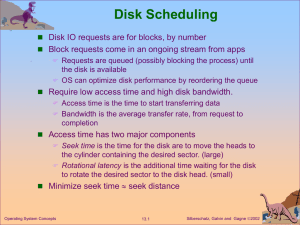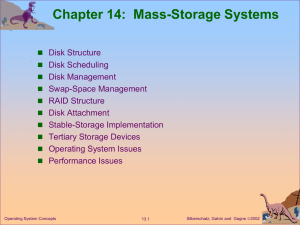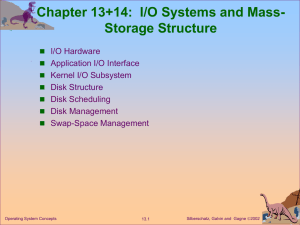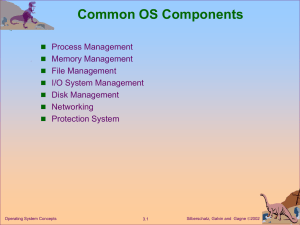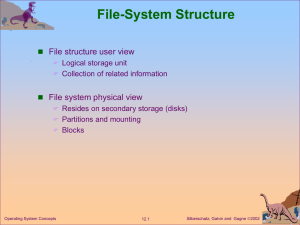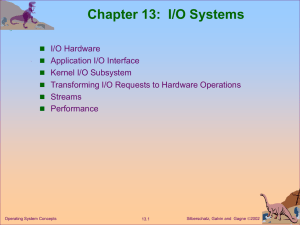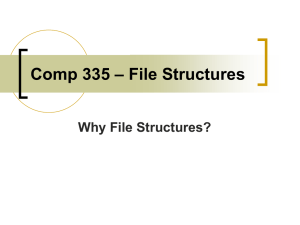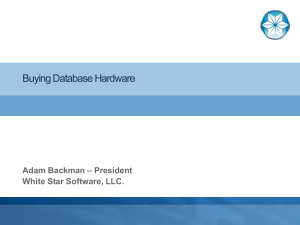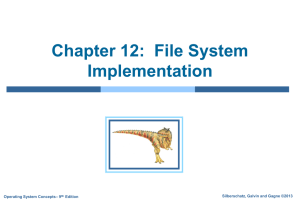Mass Storage
advertisement
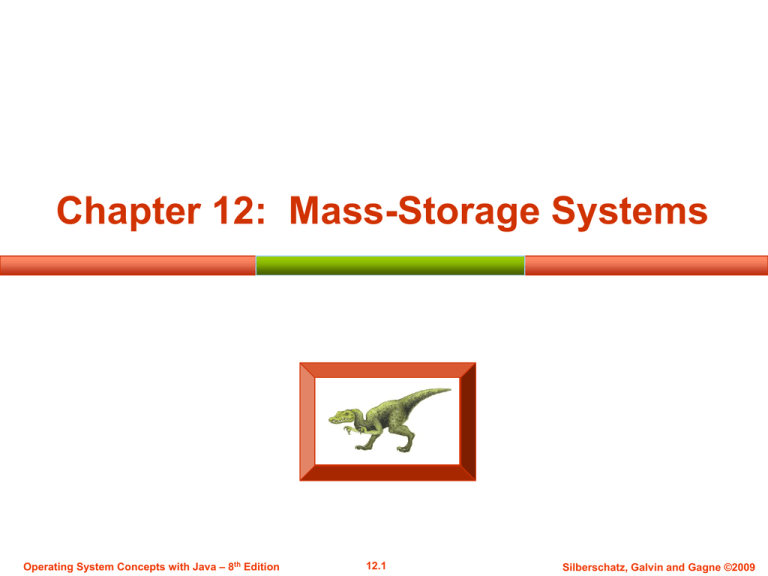
Chapter 12: Mass-Storage Systems Operating System Concepts with Java – 8th Edition 12.1 Silberschatz, Galvin and Gagne ©2009 Chapter 12: Mass-Storage Systems Overview of Mass Storage Structure Disk Structure Disk Attachment Disk Scheduling Disk Management RAID Structure Operating System Concepts with Java – 8th Edition 12.2 Silberschatz, Galvin and Gagne ©2009 Objectives Describe the physical structure of secondary and tertiary storage devices and the resulting effects on the uses of the devices Explain the performance characteristics of mass- storage devices Discuss operating-system services provided for mass storage, including RAID and HSM Operating System Concepts with Java – 8th Edition 12.3 Silberschatz, Galvin and Gagne ©2009 Overview of Mass Storage Structure Magnetic disks provide bulk of secondary storage of modern computers Drives rotate at 60 to 200 times per second Transfer rate is rate at which data flow between drive and computer Positioning time (random-access time) is time to move disk arm to desired cylinder (seek time) and time for desired sector to rotate under the disk head (rotational latency) Head crash results from disk head making contact with the disk surface That’s bad Disks can be removable Drive attached to computer via I/O bus Busses vary, including EIDE, ATA, SATA, USB, Fibre Channel, SCSI Host controller in computer uses bus to talk to disk controller built into drive or storage array Operating System Concepts with Java – 8th Edition 12.4 Silberschatz, Galvin and Gagne ©2009 Moving-head Disk Mechanism Operating System Concepts with Java – 8th Edition 12.5 Silberschatz, Galvin and Gagne ©2009 Overview of Mass Storage Structure (Cont) Magnetic tape Was early secondary-storage medium Relatively permanent and holds large quantities of data Access time slow Random access ~1000 times slower than disk Mainly used for backup, storage of infrequently-used data, transfer medium between systems Kept in spool and wound or rewound past read-write head Once data under head, transfer rates comparable to disk 20-200GB typical storage Operating System Concepts with Java – 8th Edition 12.6 Silberschatz, Galvin and Gagne ©2009 Disk Structure Disk drives are addressed as large 1-dimensional arrays of logical blocks, where the logical block is the smallest unit of transfer The 1-dimensional array of logical blocks is mapped into the sectors of the disk sequentially Sector 0 is the first sector of the first track on the outermost cylinder Mapping proceeds in order through that track, then the rest of the tracks in that cylinder, and then through the rest of the cylinders from outermost to innermost Operating System Concepts with Java – 8th Edition 12.7 Silberschatz, Galvin and Gagne ©2009 Disk Scheduling The operating system is responsible for using hardware efficiently — for the disk drives, this means having a fast access time and disk bandwidth Access time has two major components Seek time is the time for the disk to move the heads to the cylinder containing the desired sector Rotational latency is the additional time waiting for the disk to rotate the desired sector to the disk head Minimize seek time Seek time seek distance Disk bandwidth is the total number of bytes transferred, divided by the total time between the first request for service and the completion of the last transfer Operating System Concepts with Java – 8th Edition 12.8 Silberschatz, Galvin and Gagne ©2009 Disk Scheduling (Cont) Several algorithms exist to schedule the servicing of disk I/O requests We illustrate them with a request queue (0-199) 98, 183, 37, 122, 14, 124, 65, 67 Head pointer 53 Operating System Concepts with Java – 8th Edition 12.9 Silberschatz, Galvin and Gagne ©2009 First-come, first-served (FCFS) Illustration shows total head movement of 640 cylinders Operating System Concepts with Java – 8th Edition 12.10 Silberschatz, Galvin and Gagne ©2009 Shortest seek time first (SSTF) Selects the request with the minimum seek time from the current head position SSTF scheduling is a form of SJF scheduling; may cause starvation of some requests Illustration shows total head movement of 236 cylinders Operating System Concepts with Java – 8th Edition 12.11 Silberschatz, Galvin and Gagne ©2009 SCAN The disk arm starts at one end of the disk, and moves toward the other end, servicing requests until it gets to the other end of the disk, where the head movement is reversed and servicing continues. SCAN algorithm Sometimes called the elevator algorithm Illustration shows total head movement of 208 cylinders Operating System Concepts with Java – 8th Edition 12.12 Silberschatz, Galvin and Gagne ©2009 SCAN (Cont.) Operating System Concepts with Java – 8th Edition 12.13 Silberschatz, Galvin and Gagne ©2009 C-SCAN Provides a more uniform wait time than SCAN The head moves from one end of the disk to the other, servicing requests as it goes When it reaches the other end, however, it immediately returns to the beginning of the disk, without servicing any requests on the return trip Treats the cylinders as a circular list that wraps around from the last cylinder to the first one Operating System Concepts with Java – 8th Edition 12.14 Silberschatz, Galvin and Gagne ©2009 C-SCAN (Cont) Operating System Concepts with Java – 8th Edition 12.15 Silberschatz, Galvin and Gagne ©2009 C-LOOK Version of C-SCAN Arm only goes as far as the last request in each direction, then reverses direction immediately, without first going all the way to the end of the disk Operating System Concepts with Java – 8th Edition 12.16 Silberschatz, Galvin and Gagne ©2009 Selecting a Disk-Scheduling Algorithm SSTF is common and has a natural appeal SCAN and C-SCAN perform better for systems that place a heavy load on the disk Performance depends on the number and types of requests Requests for disk service can be influenced by the file- allocation method The disk-scheduling algorithm should be written as a separate module of the operating system, allowing it to be replaced with a different algorithm if necessary Either SSTF or LOOK is a reasonable choice for the default algorithm Operating System Concepts with Java – 8th Edition 12.17 Silberschatz, Galvin and Gagne ©2009 Disk Management Low-level formatting, or physical formatting — Dividing a disk into sectors that the disk controller can read and write To use a disk to hold files, the operating system still needs to record its own data structures on the disk Partition the disk into one or more groups of cylinders Logical formatting or “making a file system” To increase efficiency most file systems group blocks into clusters Disk I/O done in blocks File I/O done in clusters Boot block initializes system The bootstrap is stored in ROM Bootstrap loader program Methods such as sector sparing used to handle bad blocks Operating System Concepts with Java – 8th Edition 12.18 Silberschatz, Galvin and Gagne ©2009 Booting from a Disk in Windows 2000 Windows 2000 places its boot code in the first sector on the hard disk (master boot record). Disk divided into more than one partitions with one as boot partition, which contains OS and device drivers. Operating System Concepts with Java – 8th Edition 12.19 Silberschatz, Galvin and Gagne ©2009 RAID Structure RAID – multiple disk drives provides reliability via redundancy Increases the mean time to failure Frequently combined with nonvolatile RAM (NVRAM) to cache the RAID array. This write-back cache is protected from data loss during power failures. RAID is arranged into six different levels Operating System Concepts with Java – 8th Edition 12.20 Silberschatz, Galvin and Gagne ©2009 RAID (Cont) Several improvements in disk-use techniques involve the use of multiple disks working cooperatively Disk striping uses a group of disks as one storage unit RAID schemes improve performance and improve the reliability of the storage system by storing redundant data Mirroring or shadowing (RAID 1) keeps duplicate of each disk Striped mirrors (RAID 1+0) or mirrored stripes (RAID 0+1) provides high performance and high reliability Block interleaved parity (RAID 4, 5, 6) uses much less redundancy RAID within a storage array can still fail if the array fails, so automatic replication of the data between arrays is common Operating System Concepts with Java – 8th Edition 12.21 Silberschatz, Galvin and Gagne ©2009 RAID Levels Operating System Concepts with Java – 8th Edition 12.22 Silberschatz, Galvin and Gagne ©2009 RAID (0 + 1) and (1 + 0) Operating System Concepts with Java – 8th Edition 12.23 Silberschatz, Galvin and Gagne ©2009
